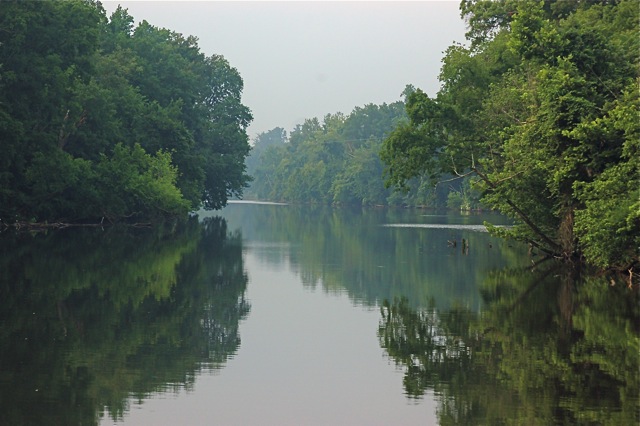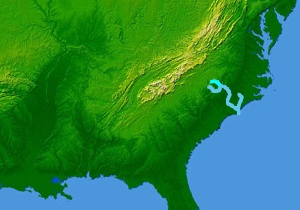- Haw River
Geobox River
name = Haw
native_name = Hau
other_name =
other_name1 =

image_size =
image_caption = Convergence of the Haw River andGreat Alamance Creek in Swepsonville, NC
etymology = Easter Souix
country = United States
country1 =
state = North Carolina
state1 =
region = Forsyth County, North Carolina
region1 = Guilford County, North Carolina
region2 = Alamance County, North Carolina
region3 = Chatham County, North Carolina
city = Haw River, North Carolina
city1 = Swepsonville, North Carolina
landmark = Jordan Lake
landmark1 =
length_imperial = 110
watershed_imperial = 1707
discharge_location =
discharge_imperial =
discharge_max_imperial =
discharge_min_imperial =
discharge1_location =
discharge1_imperial =
source_name =
source_location = Near Kernersville
source_district =
source_region = Forsyth County
source_state = North Carolina
source_country = United States
source_lat_d = 36
source_lat_m = 8
source_lat_s = 55
source_lat_NS = N
source_long_d = 80
source_long_m = 2
source_long_s = 28.4
source_long_EW = W
source_elevation_imperial = 1007
source_length_imperial =
mouth_name = Cape Fear River
mouth_location =
mouth_district =
mouth_region = Chatham County
mouth_state = North Carolina
mouth_country = United States
mouth_lat_d = 35
mouth_lat_m = 35
mouth_lat_s = 46.2
mouth_lat_NS = N
mouth_long_d = 79
mouth_long_m = 3
mouth_long_s = 9.1
mouth_long_EW = W
mouth_elevation_imperial = 154
tributary_left = Troublesome Creek
tributary_left1 = Little Troublesome Creek
tributary_left2 = Giles Creek
tributary_left3 = Stoney Creek
tributary_left4 = Boyds Creek
tributary_left5 = Back Creek
tributary_left6 = Haw Creek
tributary_left7 = New Hope Creek
tributary_left8 = Shaddox Creek
tributary_right = Benaja Creek
tributary_right1 = Rose Creek (NC)
tributary_right2 = Reedy Fork Creek
tributary_right3 = Servis Creek
tributary_right4 = Great Alamance Creek
tributary_right5 = Varnals Creek
tributary_right6 = Mary's Creek
tributary_right7 = Cane Creek
tributary_right8 = Terrell Creek
tributary_right9 = Robertsons Creek
free_name =
free_value =

map_size =
map_caption = The Haw River, shown highlightedThe Haw River is a tributary of the
Cape Fear River , approximately 110 mi (177 km) long, that is entirely contained in north centralNorth Carolina in theUnited States . It was first documented as the "Hau River" byJohn Lawson , an English botanist, in his 1709 book "A New Voyage to Carolina." The river gives its name to a small town that formed on its banks.Course
The Haw rises in the Piedmont country, in northeast Forsyth County, near the border with Guilford County just north of Kernersville. The river flows northeast, passing north of Oak Ridge and Summerfield into southern Rockingham County, passing through
Haw River State Park , north of Greensboro. The river then begins to flow southwest as it moves through the corner of Guilford County into Alamance County.In Alamance County, the Haw flows through Ossipee and passes north of Burlington, and through the unincorporated community of Carolina. It goes through the town of Haw River. It flows south and is joined by
Great Alamance Creek at Swepsonville and continues on to Saxapahaw. The river forms the southeast border of Alamance County, a border shared by Orange County and Chatham County.The course of the Haw River continues southeast in Chatham County as it flows just north of Pittsboro. Approximately 12 miles southeast of the tip of Alamance County, the Haw flows into the
Jordan Lake reservoir, which is formed by the confluence of the Haw River andNew Hope Creek . 4 miles south ofJordan Lake dam, the Haw River joins the Deep River to form theCape Fear River . [http://org.elon.edu/envstudies/BASIC/IW_map.htm Basic Info - Overview ] ]Natural History
The Haw River is home to many examples of local wildlife, including
blue heron ,beaver ,deer ,otter , bluegill bream, and other forms of wildlife. [http://www.alamance-nc.com/Alamance-NC/Multimedia/Recreation+Video/Canoeing+the+Haw+River+Corridor.htm Canoeing the Haw River Corridor - Alamance-nc.com ] ]History
The river played a major role in the life of Native Americans in the area, including the Sissipahau Indians, and in the development of the communities that were built on the river. The river was first dammed in Saxapahaw in the 1850s and used for textile mills through the 19th and 20th centuries, and was a major factor in helping
Alamance County to rebuild its local economy following the devastation of theAmerican Civil War . Alamance Plaids, a popular textile during the 1800s, were developed near the present-day community of Glencoe.During the 20th Century, the river became heavily polluted by chemicals used in the production of textiles. Conservation efforts and the decline of the textile industry in the United States in the late 20th Century have reduced pollution in the Haw River from textiles. However, the Haw is still in danger of pollution from runoff, sediment, and agricultural chemicals. Efforts are underway to improve the ecology of the Haw River, but there is disagreement between various environmental groups, local governments, and economic interests as to how to proceed. Recently, issues related to the newly revised [http://h2o.enr.state.nc.us/nps/JordanNutrientStrategy.htm Jordan Lake Rules] have added to this conflict.
Economy
Today, a few mills continue to operate near and on the Haw River, including Copland Mills in Burlington, NC. The Haw also provides drinking water and recreational activities to a large portion of North Carolina, as 10% of the state's population lives in the Haw River Watershed.http://www.hawriver.org/index.php?topgroupid=&groupid=29&subgroupid=18&contentid=59] . The conservation of the Haw River is now the focus of several groups and government agencies, who are working to develop and preserve the Haw River.
As a part of these conservation efforts has been the development of three trails. The
Haw River Trail is a conservation and recreation initiative formally undertaken by local governments and private groups in 2006, and will provide both a land trail and paddle trail connecting Haw River State Park and Jordan Lake State Recreation Area. The trail is part of the North CarolinaMountains to Sea Trail .A second major trail that has been established by local governments is the Haw River Wine Trail. The Haw River Valley has become a renowned
grape growing region as local farms have converted from the production oftobacco . This trail was originally established with five wineries in Guilford and Alamance Counties. Currently, fourwineries are open on the trail, and all four have produced award-winning wines. The fifth winery, a family-operated business, closed in January 2008. There are several other wineries in the area that are not currently part of the trail.The State of North Carolina has set up a state park on the Haw River in Guilford and Rockingham counties. There are also several city and county parks and golf courses located on the Haw, including Greensboro National Golf Club in Guilford County; Indian Valley Golf Course, Great Bend Park at Glencoe, Town and Country Park, The Challenge Golf Club, Quarry Hills Country Club, Swepsonville River Park, and Southwick Golf Course in Alamance County; and Robeson Creek Recreation Area and New Hope Overlook Campground located at the Jordan Lake State Recreation Area in Chatham County.
Tributaries
* New Hope Creek
* Robeson Creek
* Cane Creek
* Mary's Creek
* Great Alamance Creek
* Town Branch
* Quaker Creek
* Back Creek
* Stoney Creek
* Buffalo Creek
* Reedy's Fork
* Troublesome CreekCities, Towns, and Communities
In Chatham County
*Haywood, North Carolina
*Bynum, North Carolina In Alamance County
*Saxapahaw, North Carolina
*Swepsonville, North Carolina
*Graham, North Carolina
*Haw River, North Carolina
*Burlington, North Carolina
*Carolina, North Carolina
*Glencoe, North Carolina
*Ossipee, North Carolina
*Altamahaw, North CarolinaIn Guilford County
*Oak Ridge, North Carolina In Forsyth County
*The Haw begins approximately 1 mile northeast ofKernersville, North Carolina .Dams
The Haw River has been dammed many times throughout its history to provide power for mills, irrigation for crops, and drinking water supplies. Some remnants of dams are still visible. The following dams are still extant on the Haw RiverDams located using Google Earth.] http://www.ncwater.org/About_DWR/Water_Projects_Section/Instream_Flow/hydropictures~cfear.html#haw] :
*B. Everett Jordan Dam - 113 ft.
*Bynum Dam - 8 ft
*Saxapahaw Dam - 30 ft.
*Southwick Golf Course Dam - 10 ft.
*Old Swepsonville Dam - 5 ft.
*Granite Mills Dam
*Glencoe Mills Dam - 10 ft.
*Indian Valley Dam
*Altamahaw Dam - 8 ft.External links
* [http://www.thehaw.org The Haw River Trail]
* [http://www.hawriverwinetrail.com The Haw River Wine Trail]References
Wikimedia Foundation. 2010.
